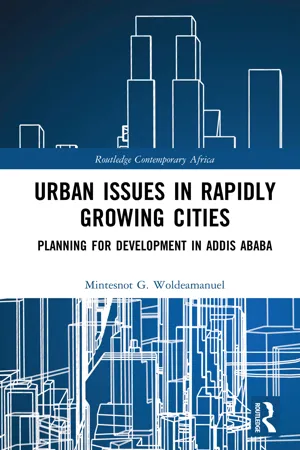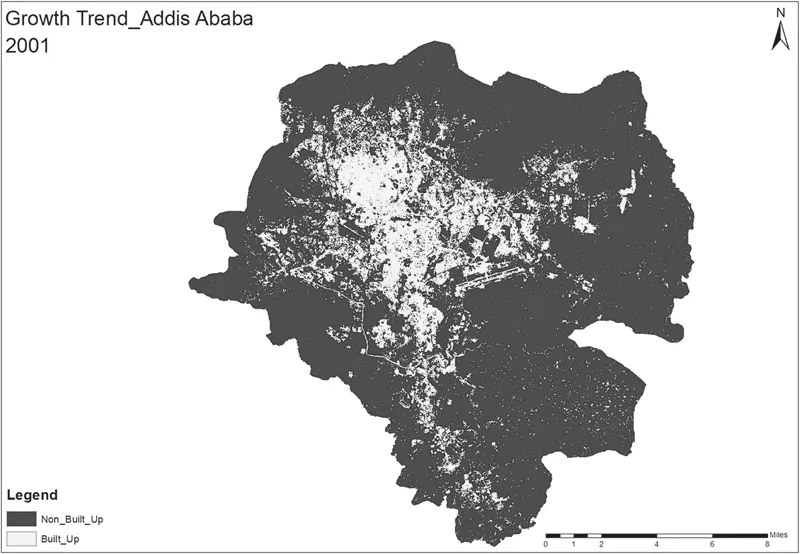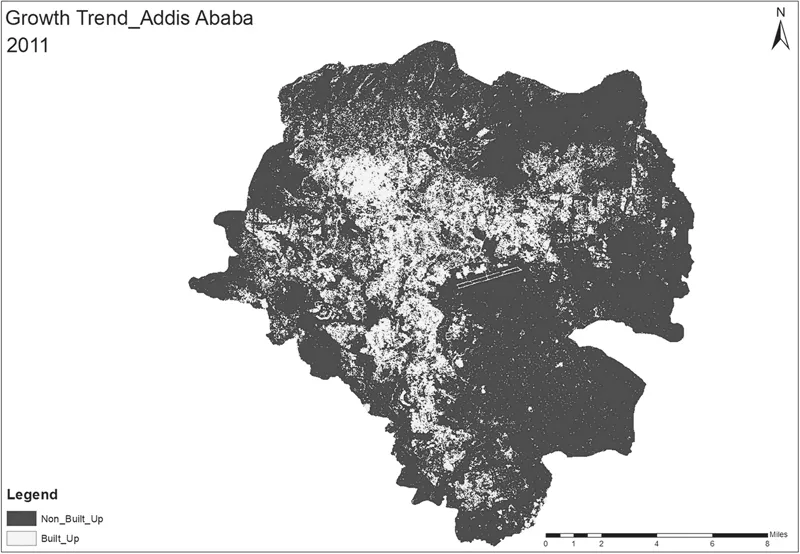E.Y. was born and grew up in a neighborhood at the periphery of Addis Ababa called Gurara, which is located in the northeastern part of the city. Growing up, his parents’ home was one of the few scattered houses in the area. The rest of the neighborhood was covered with green forest. It was common to hear hyenas hoot-laugh at night. The only link between E.Y.’s house and the high school was a narrow, dusty street. When he got to school, students often laughed at him because of the dust or the mud that covered his shoes. He remembered, when his parents tried to sell the house, there were no interested buyers. The area was too far and too disconnected. During his college years, he started to observe some changes. During a semester away from his parents, he saw a housing project underway for city residents who were relocated from a demolished slum area at the city center. A developer wanted an area at the core of the city for re-development, so Gurara was chosen for the relocation of the slum settlers. Then, other developments followed, both formal and informal. Soon, property value went up unbelievably faster than many would have guessed. In the four years that he had been a university student, E.Y. visited his parents at the end of every semester. Every semester, the development in the area was accelerating quickly, engulfing those original scattered settlements.
Fast forward to today and E.Y. still lives in his parents’ house with his wife and three children. When his parents passed away, he inherited the house. Gurara is now a crowded residential and business center. The area is connected to the rest of Addis Ababa with a wide asphalt road. There are new schools, places of worship, and small-scale industries. The public bus system has expanded to serve the area’s population. All these changes happened in the last 20 years. Now, when he sees the adjacent neighborhood called Ankorcha, which is covered with green forests, he feels disheartened. Sadly, an informal peri-urban land transaction is happening in the area. Small houses in the middle of the beautiful forest are popping up overnight, and they are up for sale. What is the guarantee that in the coming 20 years the beautiful Ankorcha will not be turned into the likes of Gurara? E. Y. always wonders. This is the story at the peripheries of Addis Ababa in all directions and of many cities in rapidly growing countries, especially in Africa (Map 1.1).
Rapidly growing African cities
The UN Population Prospects Report1 predicts that from 2018 to 2035, the world’s top 10 fastest growing cities will be in Africa. By 2040, the urban population in Africa will double. This is by far the highest rate of growth when compared to cities in other continents. Rural-to-urban migration and the natural growth rate contribute to this surge in African urbanization. Africa is leading in total fertility rates. For example, average children per women for the African continent between the years 2015 and 2020 is 4.4, whereas the world is 2.5, and Asia is 2.1 (UN Population 2015).2
Africa has become the most rapidly urbanizing continent, yet the characteristics of its urbanization process are different from other continents. Theoretically, urbanization leads to economic development. The most urbanized countries of the world went through a rapid urbanization before they reached economic prosperity. When the significant economic activities of a country move from agriculture to manufacturing, industry and service, the predominantly rural population gradually transforms to urban. Nguyen and Nguyen (2018)3 found that there exists a causal relationship between urbanization and economic growth, and urbanization positively affects economic development. However, the relationship between urbanization and economic growth is nonlinear. While Africa’s urban population is growing so fast, the expected transformation of the economy from agriculture to manufacturing is somewhat slow.
Still, some studies revealed that urbanization is a catalytic power for Africa’s economic growth. In fact, the current rise of Africa on the world’s economic map is due to the growth of cities as an engine of productivity. The McKisney Global Institute, a research organization in economic development, published a report in September 2016 with the title “Lions on the Move II”.4 The report highlights African growth and its place in the world’s economic development trend. The report’s message is clear that Africa is growing fast, and that the continent’s economic fundamentals are strong, and of the many reasons cited for the economic growth, fastest urbanization is one of them. Urbanization has a strong correlation with the rate of real GDP growth, according to the report. Productivity in cities is more than double that of rural areas. There are higher rates of productivity in cities, and this translates into higher incomes. Cities also supply better access to infrastructure, social services, and new markets.
Nonetheless, rapid urbanization has several detrimental effects on the social, economic environments and political aspects of cities in Africa. Some lead economists such as Somil Lall from the World Bank stated that Africa’s urbanization is growing faster than its GDP. Africa is 40% urban, but its per capita GDP is roughly $1,100. By the time Asia reached 40% urbanization, its GDP per capita was $3,500. A World Bank report written by Lall and his colleagues pointed out a deeper economic problem than this. African cities are closed to the world in terms of production and trading. In order to grow economically as they are growing in size, African cities must open their doors to the world (Lall, Henderson, and Venables 2017).5 The provision of basic infrastructure and services is also a challenge that African cities are facing due to rapid urbanization. Many African cities provide low access to public services such as water, electricity, health, schooling, and other important services. Although density in cities increases economies of scale in providing services, poor urban planning and management of a growing population cause low provision of services and overburden an existing infrastructure. According to the compiled work of Guneralp (2017), urban growth in Africa is characterized by unplanned and unregulated expansion with weak urban planning institutions. Unemployment rates are high, and about 60% of jobs are informal, which leads to underestimated economic activities in cities of Africa. Land markets are unregulated, and there are limited provisions of infrastructure and services.
While urbanization increases the national and regional economies, it also presents many social, environmental, and quality of life challenges. Rapid growth brings a shortage of houses and the emergence of slums and squatters. In sub-Saharan Africa, 72% of urban residents live in slum areas and only 54% of African urban population has access to sanitation.6 Therefore, African urbanization is at the juncture of opportunities and challenges. If the rate of growth continues like this, as projected by the UN and World Bank, it can be difficult for African governments and city planners to manage cities and create a sustainable urban future. Cities continue to be concentrations of the national economy, but that in turn attracts people from the countryside to migrate to urban areas. This creates unmanaged growth and a mismatch between the demand and supply of services and infrastructure. Therefore, African urban areas need good management and innovative planning that break the cycle. Urbanization is a process in which many countries in the world transitioned from low-income status into middle-income countries. African urbanization is becoming an engine of economic development, as is evident in the recent economic history of many countries of the continent. However, African cities must equip themselves with the capacity of urban management to mitigate the unintended risks of urbanization and tap into opportunities to reach the goal of balanced and sustainable growth.
Framing the African continent in general, and African cities in particular, as a godforsaken place is gradually becoming outdated. The economic progress, the global link, the technological advancements, and the social development Africa exhibits—especially for the last couple of decades—brought the continent to the world map as a global partner. African cities went through several transformations with mega projects and urban revitalization programs. This is not to say that African cities are without problems. There are several challenges caused by the progress and the change itself. There are also environmental threats and socioeconomic challenges that the cities are facing.
So in this time of progress, with opportunities and challenges, how can one frame African cities? What are the conceptual frameworks that define the everyday function of cities? How do these frameworks apply to Addis Ababa, the focus of this book, which I liberally call an epitome for developing African cities? For several years, Hollywood movies played a significant role in portraying Africa and its cities as old, rugged places where living and working in them was not enjoyable. Cities plagued with war, crime, and poverty have been portrayed in many movies. Although recent movies such as Black Panther painted a new, positive, and strong picture for Africa, those negative images are still imprinted in many people’s minds. Nigel Eltringham, in his edited collection of “Framing Africa.”,7 excellently depicted the positive and negative portrayal of Africa in the wave of films on Africa. The book served as a window to see the world’s relationship with Africa by demystifying the unfair framing of African cities as a bad place. Although African cities are not entirely free from their shortcomings, they are growing fast, creating opportunities for their residents and the national economic growth. Accordingly, if there is one phrase that describe cities in Africa, it is “cities of opportunities and challenges,” and Addis Ababa is not an exception to this.
Strength and weakness of city planning
Cities in Africa have many internal strengths for their growth and development. Their people are strong, hardworking, resilient, and resourceful. When there is no formal means to obtain access to services, they seek an informal way of getting them. It is not because they want to be informal, but the system makes them that way. Access to education is increasing with specialized fields such as urban planning and design that is shaping cities, arguably for the better. Also, diversifying economic activities and the increased collection of revenue by cities are improving, helping them generate more money for urban development projects. Their global link and technology transfer have also increased over the last few years, with the potential of tapping into resources beyond their national boundaries.
Yes, there are several planning and development potentials, but at the same time, there are shortcomings and weaknesses in plan making and plan implementation. Although the capacities of municipalities have increased, the number of urban planning professionals is at a very low level. Planning professionals with technical expertise are few in the market. Because of that, plan preparation is not done properly, which is reflected in the weak implementation and the informal nature of city development. Often, population forecast and prediction of demand are far off the reality. Vanessa Watson and Babatunde Agbola, in their piece Who will plan Africa’s cities? published in 20138 by the African Research Institute, acknowledge that a shortage of urban planning and management professionals trained to respond to urban complexity with progressive pro-poor approaches exacerbates urban dysfunction in Africa. Some African countries have no planning school, so a reform and revitalization of planning education could contribute significantly to sustainable and more equitable urban development in sub-Saharan Africa.
There is also limited public participation in the planning process. The community has limited say on goal setting and planning alternatives. Planning documents are out of the public’s sight, and there are limited follow-ups and follow-throughs. Planning does not take sustainability and resiliency strategies into consideration. Such planning shortcomings lead to implementation problems that drive African cities toward unplanned and informal development. At times, politicians prefer their interests over the best-laid plan. Personal interest and corruption play a significant role in improper implementation of plans.
Plan making and plan implementation in Addis Ababa are somehow similar to cities of many developing countries, especially in sub-Saharan Africa, as are the problems associated with urban planning. For example, Kampala, the capital of Uganda, a city with a density of 9,430 population per square kilometer, has planning challenges to deal with its many urban problems such as solid waste management, housing, and transportation. Development control in Kampala is difficult because of the absence of development control mechanisms in place. The city’s master plan is somewhat changing that by helping control land uses. Its population increase poses a challenge for the proper implementation of plans. The structural plans prepared at different times in the city’s history were challenged by a growing population. Still, Kampala is functioning with a transportation system that is not well-managed, services with unmet demand, and slum areas with lack of basic facilities, which shows lack of proper planning. The story is not different for Dar es Salaam, the capital of Tanzania, a city with population growth of 4.2% per annum. The city has been following its land use and zoning plans of 1942, which were based on not only land function but also race and ethnicity. However, its 1968 plan was based on a systems approach and environmental considerations with a regional planning touch to it. The 1979 plan was unique in that it was based on population attained rather than target years, and it had a detailed implementation strategy. Although Dar es Salaam has known planning since 1891 when the first scheme was drawn up by the German colonial authorities, the recent comprehensive plan (2012–2032) is guiding development right now. This is a plan done 30 years after the 1979 plan was made. This time gap created unplanned and unregulated deve...



